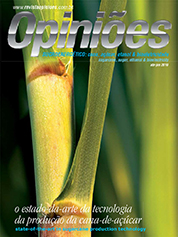José Alexandre Melo Demattê
Professor of Geoprocessing of Esalq-USP
Op-AA-24
Geotechnology in planning and developing sugarcane
With large scale agriculture and information being required instantly and rapidly, planning has become even more important, given that it may define a sugarcane unit’s future. As a means of support, several types of equipment and techniques are now available: the Geotechnologies. Since 1930, it is known that soil fertility varies in any given area. However, because at the time there was no technology to apply fertilizer in a localized manner, one used the large scale system that we know to this day.
In the beginning of the 1980’s, the Americans noticed that plants varied in terms of vigor in any given area. Now, with GPS, it would be possible to install equipment on a tractor and make applications at variable rates, while evaluating productivity. Geotechnology helped in creating Precision Agriculture. Another aspect of this issue is remote sensing (RS).
In 1972, the first thrust forward took place, with the Landsat satellite. The marketing of images began in 1990, the time when the use of computers in Brazil started to increase. There were signs that data processing speed would in-crease sevenfold. In 2005, with the appearance of Google Earth, images became popular. Geographic Information Systems (GIS), another variable, were progressing.
The prediction that information acquisitions would accelerate was becoming reality. All these processes, however, were evolving in parallel. The need for special viewing (geo) in agriculture began to gain momentum. It was no longer a matter of evaluating tables, but rather data organized in relation to a space, transforming located information into spacial information, and becoming strategic in nature (theme maps). Since the evaluation of information in agriculture is associated with variables of nature, one then observed the need to obtain historical information on areas, in order to plan agricultural practice.
This was the beginning of the Database concept. From history to practice: the identification of stains in a stand of sugarcane using RS is a reality. The use of images to identify such variations requires care, given that many variables interfere in the shades of such images. Hence, the importance of knowledge of field versus image, coupled with a database and assessed by a GIS.
Satellite images can thus be used to evaluate soil or plants. In terms of soil, images help in mapping, constituting the base for obtainment of production environments. Research shows that it is possible to detect surface soil texture through RS. Since information is about the surface layer, it is integrated into the so-called Digital Soil mapping, which aggregates the terrain profile.
Other studies assess the use of portable radar devices and gamaspectrometric sensors to define the variation in soil depth. Images have increasingly better resolutions, and new satellites are being launched, including hyper-spectral ones. The strategy of using images and sensors can be applied through plants, determining hydric stress, nutritional alterations, estimates on productivity and monitoring.
However, there is an important practical issue. The quantity of information generated is large, so there is a need for GISs and statistics. Prog-ress has been made along these lines, but success is linked to the integration with field experience. There are clear associations between nutrition and the plant spectrum. Agriculture has reached a limit that can only be overcome with the support of geotechnologies.
For example, the advantages of using images as support in selecting areas for implementing and expanding mills are quite impressive. Other research follows the line of quantifying soil using sensors in labs. When installed on tractors, the objective is to obtain information on soil analyses in real time (based on data obtained as the comparable standard in labs) and the immediate application of the input. This is quite complex and perhaps somewhat out of the ordinary, but it is what is being appraised.
No doubt cost is a factor preventing the popularization of these techniques. However, it can only be reduced if their use increases. Coming back to history: sugarcane culture evolved thanks to decades of experimenting. Nowadays, vinhasse (previously disposed of), filter cake and agricultural plaster (previously given away for nothing), are widely used in the fields.
The exact dosages and the proper handling of these products were defined thanks to experiments conducted in sugarcane units. Does one expect the same outcome when using geotechnologies? How does one interpret results, adjust, learn and foster use? Following the same line, it will certainly be through experiments, with the objective of checking out what is or is not possible, and by adjusting the standards to reality. It is necessary to integrate experimentation with historical data, seeking to understand the results and to take a leap forward into the future.
At this point, Brazil has what is most important compared with other countries, i.e., the basic raw material: land and climate. Researchers in Europe and Australia have insistently sought partnerships with Brazil for experimenting in geotechnologies. One should point out that the convergence process is in progress in all areas of geotechnologies, which, once integrated with traditional knowledge on management, will surely place us in the lead position in global agriculture.




